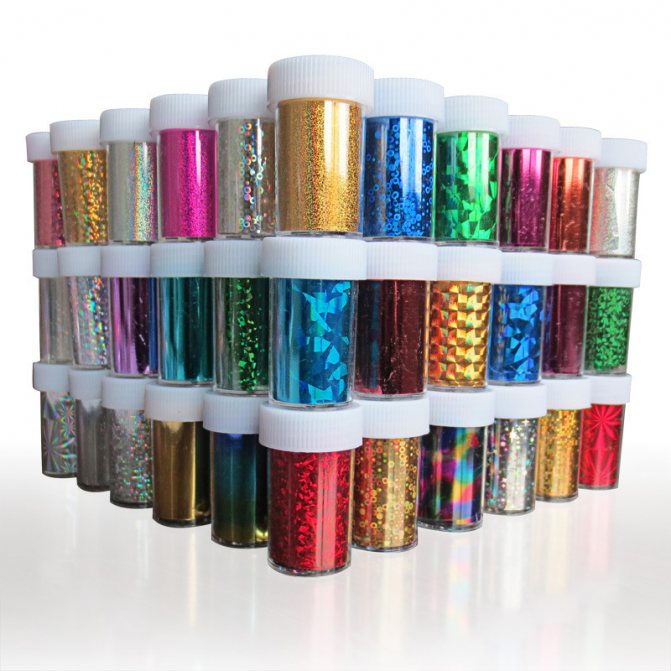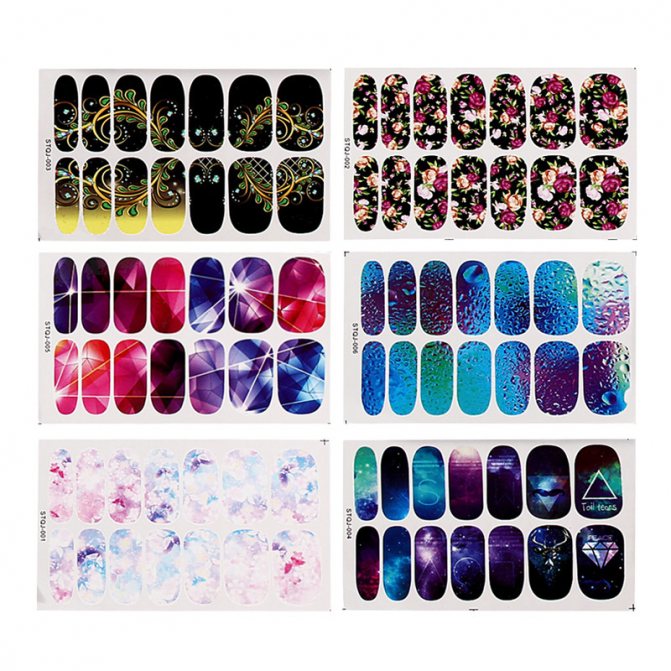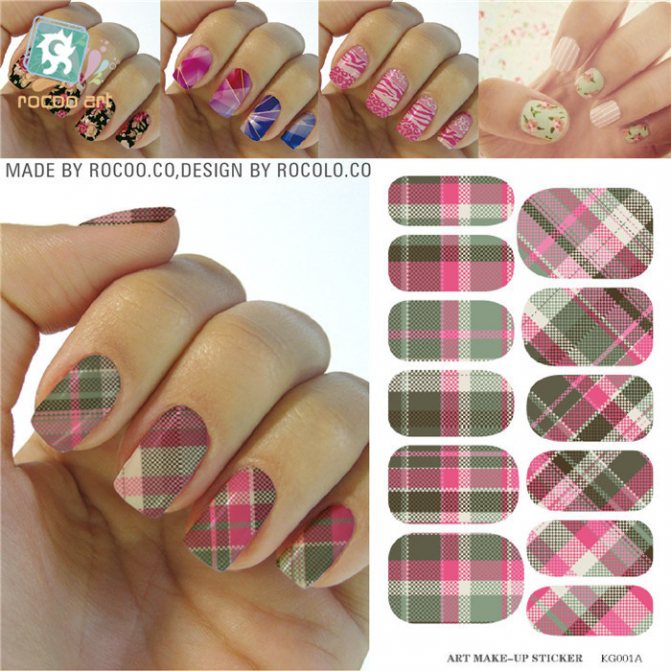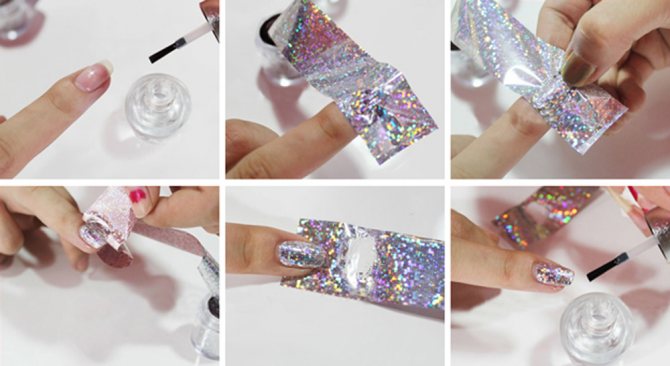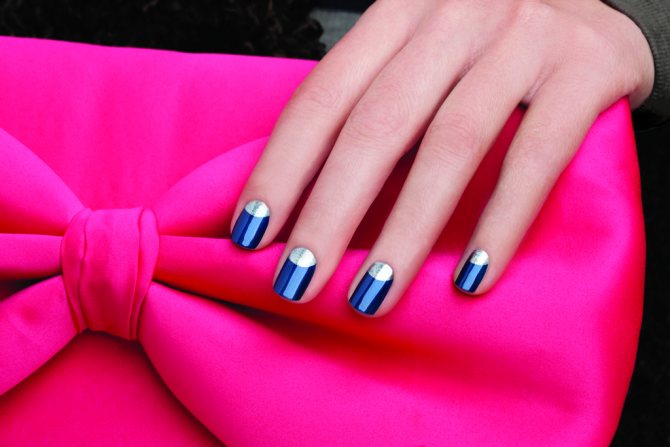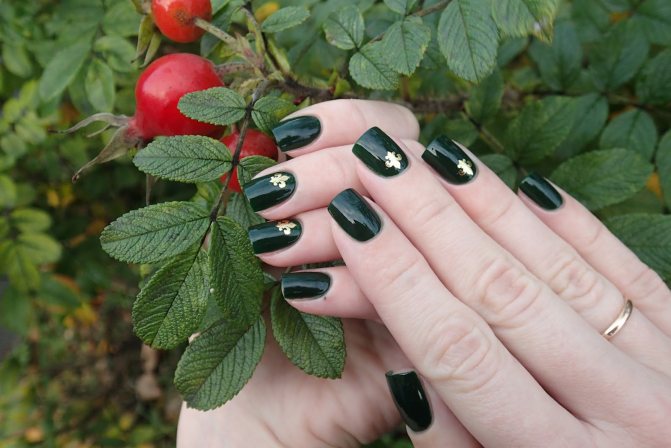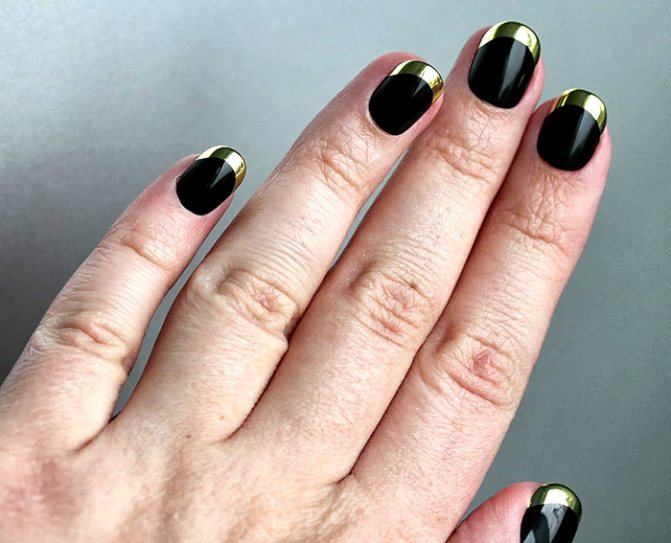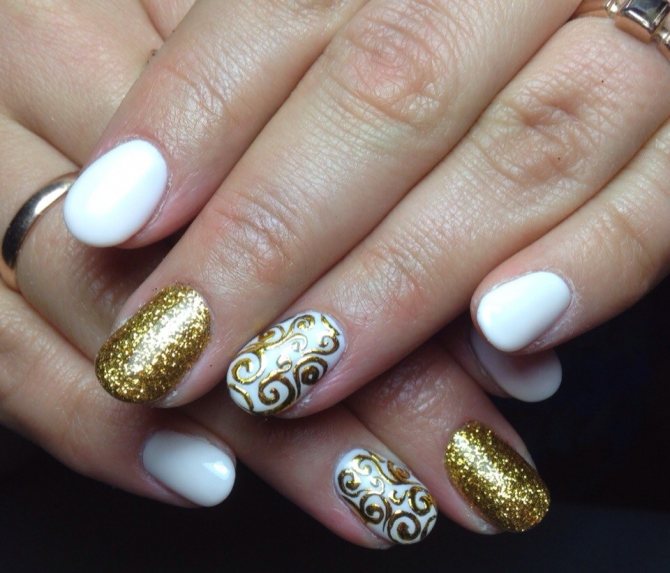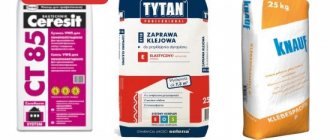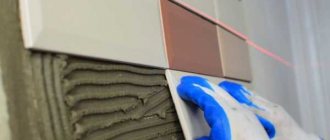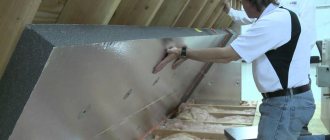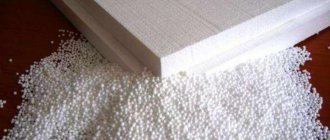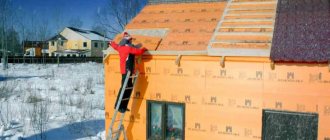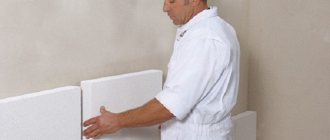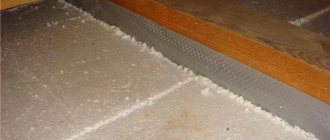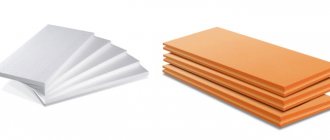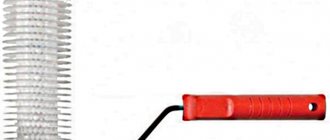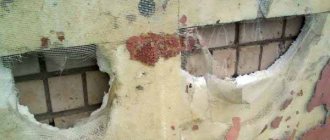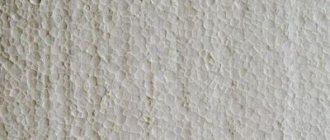Material application
Penofol is a foamed polyethylene, covered with aluminum food foil on one or both sides. The finished insulation thickness does not exceed 10 millimeters.
The popularity of penofol as a building material is explained by its properties: it does not absorb thermal energy accumulated in the room, but reflects it. The purpose of this material is to trap warm air in winter and cool air that has accumulated in the room during morning ventilation in summer.
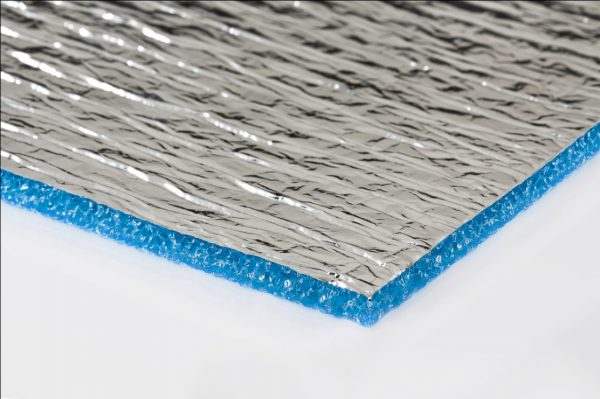
Insulation
Penofol can be used in other cases, for example, for isolation:
- piping systems;
- premises from external noise;
- hydro and steam systems;
- ventilation shafts.
It is also often used as a reflector of the thermal energy of a heating radiator, as an attribute for decorating the surfaces of the ceiling, floor or walls.
How to glue foamed polyethylene: choose glue


There are a large number of insulation options on the market. Foamed polyethylene is the most frequently chosen because it has impressive steam, heat and sound insulation properties. The choice in today's market is really great. The proposed options can have a self-adhesive surface, can be foiled on one side, or on both sides at once. On sale there are such types of foamed polyethylene as isolon, polyfom, penofol. The insulation can be attached to different materials. And depending on all its characteristics, glue is selected.
Penofol glue
Finishing and renovation work often involves bonding various building materials together. Sheet or roll insulation cannot be fixed on insulated structures without special devices, otherwise their heat-insulating properties will be lost, and their wear will be faster.
The content of the article
For such purposes, the material penofol is optimal, which has a layered structure and consists of aluminum foil, supplemented with polyethylene foam. It is characterized by low thickness and low weight, as well as ease of installation.
Such material is used for finishing building structures, units of specialized machines and whole mechanisms, individual parts of technical equipment on a production scale, pipelines, air conditioning systems, drying cabinets, as well as inclined surfaces with a complex profile.


In order to ensure maximum steam, thermal, hydro and noise protection, Penofol must be glued to a previously prepared surface (cleaned and well dried).
Before proceeding with the gluing of Penofol and the work surface, it is recommended that you familiarize yourself with the instructions for the selected adhesive. However, there is one rule that applies to working with any adhesives, namely, all surfaces to be bonded must be clean and monolithic.
Previously, it is worth eliminating the existing chips and cracks, even the smallest irregularities, pollution, blockages of various origins. If wooden, metal, polymer surfaces need a primer, its chemical composition should be suitable for the selected type of adhesive. This is the only way to ensure maximum and strong adhesion of the bonding surfaces.
The adhesive method of attaching penofol to insulated surfaces has a number of advantages: it is technologically uncomplicated, does not require any professional tools and skills, and is inexpensive in terms of money and time. The only limitation of this method is the load-bearing capacity of the adhesive bond, which determines the maximum weight of the bonded coating. However, in the case of penofol, this factor is not of great importance, since foil-clad penofol and its analogs are very lightweight materials.
How to choose the "right" glue for penofol from all the variety produced by modern industry?
A good bond quality depends on the degree of adhesion of the material to the adhesive, i.e. the ability of the latter to penetrate into the smallest pores and irregularities of the material and adhere to it. Let's make a reservation right away that any material based on an organic polymer (including penofol), if it is not porous, has low adhesion.
In addition, it must be remembered that there are no universal solvents in nature. Each of them is more "specialized" in one kind of materials. Therefore, the so-called "universal" adhesives are in fact adhesives that glue everything equally badly. For such a specific material as penofol, it is better to choose a specialized glue.
In addition to the above characteristics, which are decisive for the choice of glue, there are a number of conditions that depend on the specific construction task. So, for example, due to the peculiarities of penofol when insulating the walls of a building, the glue used must be resistant to the effects of water and water vapor.
When using glue in a residential area, its safety for human health and the environment comes to the first row. Many manufacturers, especially foreign ones, are trying to obtain EMICODE toxicity certificates from the Association of European Manufacturers of Construction Chemicals GEV for their products. Such a certificate means that the glue is safe for human health and does not emit harmful vapors.
Application rules
How to properly use glue for gluing penofol and its analogs? Usually, to obtain an effective gluing, it is sufficient to strictly follow the instructions for use offered by the manufacturer. The basic rule when using any adhesives is that the surfaces to be glued must be smooth and clean. The explanation for this is very simple.
If the wall is dusty, the glue sticks, first of all, dust, and, accordingly, its effectiveness is sharply reduced. When there are large cracks, potholes, etc. in the surface, the consumption of glue is greatly increased, and the place of gluing itself will be uneven.
Therefore, before gluing penofol, first prepare the surfaces - clean from dust and dirt, close up irregularities. In some cases, it is necessary to apply special primers before gluing - they increase the adhesion of materials. Observing these rules, you will stick penofol anywhere, easily and without problems.
There are a large number of insulation options on the market. Foamed polyethylene is the most frequently chosen because it has impressive steam, heat and sound insulation properties. The choice in today's market is really great. The proposed options can have a self-adhesive surface, can be foiled on one side or on both sides at once.
Izolon (penofol) is covered with aluminum foil, which allows you to keep warm in the best way. Its adhesion to the surface of the insulation can be chemical or physical, that is, sewn. Isolon can have additional characteristics such as thickness or color. If you are looking for a win-win insulation for your home, then this option will be the best choice.


Among them are:
- small thickness;
- ease of installation;
- ecological cleanliness.
Insulation installation is possible without the use of special tools. Working with polyethylene foam does not require additional protection of the respiratory tract and skin. The material is so light that the load-bearing capacity of the adhesive will not be critical.
How to choose glue
On sale there is a fairly wide range of various adhesives for working with foamed polyethylene. And it is advisable to make the choice using the following criteria.
- The temperature range must match this characteristic of the insulation.
- The adhesive properties must be extremely high.
- If the glue is to be used for interior decoration, then it must be certified and non-toxic.
- If the glue is chosen for exterior decoration, then it must be resistant to a variety of weather conditions and temperature extremes.
- If you intend to deal with the decoration of the sauna and bath, then the glue will need to be mixed with water-repellent agents.
For working with isolon, water-based glue is categorically not suitable, because it does not allow the adhesive to penetrate into all the pores of the insulation. Consequently, the level of adhesion will be insufficient.
Adhesive types
Let's list the most commonly used glue options.
- For rooms with high humidity, MV-40 is suitable, which has moisture resistant properties. You can also choose T-Vanguard-K.
- For residential premises, "Express" or "Universal" is usually used.
- When it comes to the installation of external building structures, then it is most advisable to choose liquid nails or assembly glue. For example, Moment Montage will do.
- Titanium is good for precast concrete base.
- Neoprene-2136 in the form of a spray or contact type Acrol is selected for adhesion to foam.
- Olfix and Ceresit are universal glue options. They are perfect for working with any kind of surface, including concrete.
- Atlas Stopter K-2 kley is chosen if you plan to glue insulation on a mineral base.
- Weicon Easy Mix PE-PP-45 is selected for bonding polypropylene to polyethylene.
After the work, the seams will need to be treated with Tilit or a specially designed adhesive tape. The choice of glue is largely determined by the purpose of the room that you plan to insulate, whether you will attach it to wood, metal, concrete, etc. etc. Choosing on your own, without having a lot of experience in the implementation of construction and installation work, can be difficult. And therefore it is always advisable to consult with specialists.
Overview of adhesives for mineral boards
On sale there are various compositions for fixing insulation, they are produced by almost every modern manufacturer of adhesives and building mixtures. The most popular ones are described below.
Mineral wool adhesive EK Thermex
The tool is used for arranging thermal insulation systems, suitable for external and internal work. It is ideal for fixing mineral wool, expanded polystyrene, reinforcing heating systems on concrete and brick substrates. The glue is distinguished by its plasticity, frost resistance, high adhesion level. Its main technical characteristics:
- color - gray;
- base - cement;
- solution life time - 3 hours;
- consumption - 5-6 kg / sq. m;
- layer thickness - 3-8 mm;
- temperatures during work - + 5 ... + 30 degrees;
- adhesion - 1 MPa;
- frost resistance - 75 cycles;
- operating temperature - -50 ... + 70 degrees.


Ceresit CT 180 glue
Dry mix "Ceresit" is produced on the basis of cement, polymer fillers and modifiers, it is used for fixing mineral wool insulation from the outside of the house. The agent can be applied at temperatures above 0 degrees, it has high adhesion to most substrates (0.8 MPa), it is resistant to tearing. Good vapor permeability ensures stable and efficient removal of vapor, which inevitably forms during the evaporation of liquids. Other properties and technical parameters of the glue:
- environmental Safety;
- consumption - 5-6 kg / square meter;
- dry mix density - 1.4 kg / sq. dm;
- density of the finished mixture - 1.6 kg / sq. dm;
- water norm - 5-5.75 liters per 25 kg;
- the pot life of the solution is 2 hours;
- open time - 20 minutes;
- frost resistance - 100 cycles;
- operating temperature - -50 ... + 70 degrees;
- the color of the finished adhesive layer is yellow-gray.
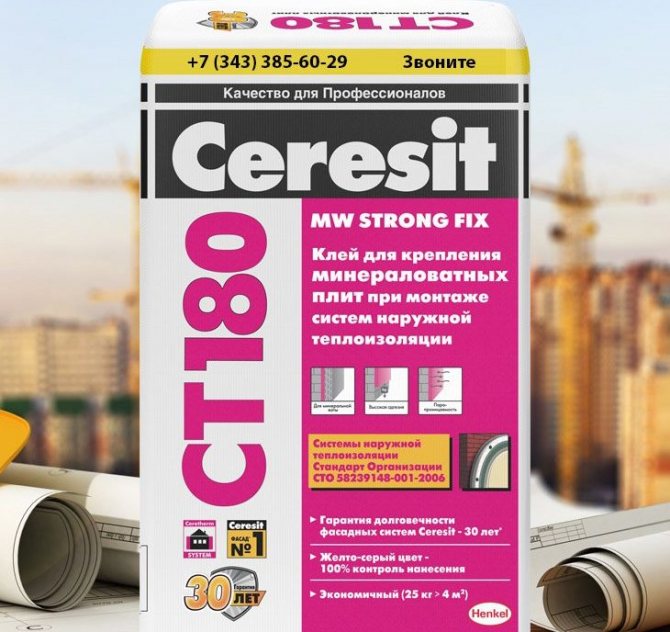

Ceresit CT 190 glue
This product is ideal for basalt insulation, for example, Izovol cotton wool. The main field of application concerns the external bonding of mineral wool boards, but internal use is also possible. The glue is available in “winter” and “summer” versions, which allows you to use it at any time of the year. "Ceresit CT 190" is suitable for self-fastening of plates, as well as for gluing in combination with a reinforcing fiberglass mesh.
The advantages of the composition are as follows:
- long service life (several decades);
- excellent quality of adhesion to mineral wool and base;
- the presence of reinforcing fibers in the composition;
- high impact strength;
- resistance to atmospheric factors, moisture;
- environmental Safety;
- vapor permeability;
- elasticity.
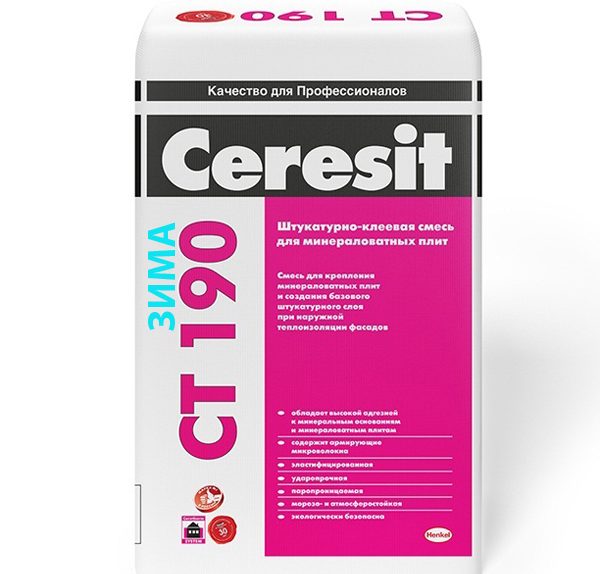

Like other adhesives, this product is sold in 25 kg bags. Its consumption is approximately 6 kg / square meter. The open time of the solution is 40 minutes, the operating temperatures are from -50 to +70 degrees. Adhesion to concrete is 0.6 MPa, to mineral wool - 0.5 MPa, frost resistance - 75 cycles.
All adhesives, when used correctly, will help you quickly, without the need for special skills, to attach thermal insulation. Mineral wool is an inexpensive and high-quality option for home insulation, and in combination with good glue, it will serve for many years.
Penofol varieties
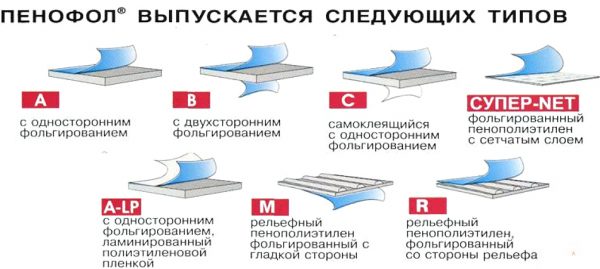

Penofol types
The most common option is a material covered with foil on one side only. It is marked "A". Most often, craftsmen prefer to lay it.
There are also other types of penofol:
- covered with foil on both sides (marked "B");
- on the one hand - foil, and on the other - a self-adhesive coating (a product of this type is marked with the letter "C");
- there is a metal layer on both sides, and one of the foil sides is covered with an additional layer of film (this type is marked with the letters "ALP");
- only one side is covered with foil, the other is provided with a relief pattern (similar products are marked with "M" and "R").
Penofol, marked with the letters "AIR", is used to equip air ducts. Products that are used for heating mains, about. As an independent heat insulator, only penofol marked "C" is used, however, provided that the room temperature does not drop to very low rates.
What glue to glue foamed polyethylene
When choosing insulation, a special place is taken by foamed polyethylene - a material with sound, heat and vapor insulation properties. Depending on the manufacturer, it can be penofol, isolon or polyp. The construction market offers different types: with one-sided or double-sided foil, as well as with a self-adhesive plane. The material on which the insulation is fixed also varies. Based on all the parameters, it is necessary to be able to choose the right adhesive for foamed polyethylene.
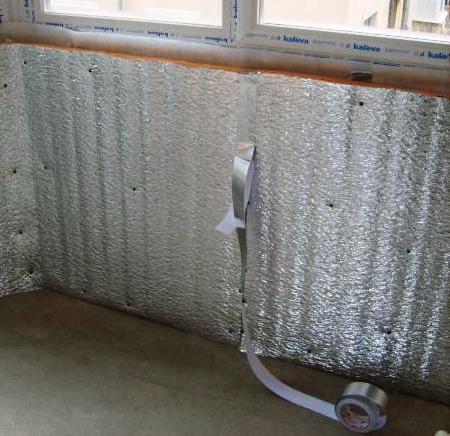

How to glue penofol to concrete, what to glue insulation with foil on


Laying insulating material on the floor
In this case, the material is usually used as an additional layer.The main one is foam, expanded clay or expanded polystyrene under the screed. In addition to penofol and the main thermal insulation material, the contractor must have at hand a metal (or wooden) crate, tools for installation and locksmith work, an adhesive solution (or hardware), as well as wooden logs.
The following can be used as an adhesive solution:
- liquid Nails;
- Double-sided tape;
- polyurethane foam (applied in a thin layer).
Sequence of execution:
- Before proceeding with the insulation work, it is necessary to level the floor using a concrete screed for this purpose. Lay a foam or expanded clay base.
- The role of a wooden frame is recommended to be assigned to logs impregnated with an antiseptic composition or to use a metal frame. Products are laid on an insulating layer, and cladding is placed on top of it.
Hello. We will try to answer your question.
Penofol is an energy-saving material with a laminated structure. It combines the properties of foamed polyethylene and thin aluminum foil. The material is characterized by lightness and low thickness, and therefore is often used on various objects (including on the balcony) for insulation, ensuring tightness, thermal, noise, steam and waterproofing. However, to ensure high-quality protection, penofol is not enough to lean against the insulated surface - you need a special glue for penofol.
A large number of modern finishing materials require a certain fixing.
Roll or sheet insulation, such as penofol, is best fixed to the surface with glue. This way you can completely avoid the loss of technical properties of the material.
Glue for penofol is chosen taking into account which surface the heat insulator will be fixed to.
Fig. 1 Penofol on the concrete structure of the balcony
Penofol is a foamed polyethylene coated with an aluminum technological foil. Installation of the canvas is not difficult due to the lightness of the material. It is used not only in construction. It is perfect for thermal and sound insulation of machine parts.
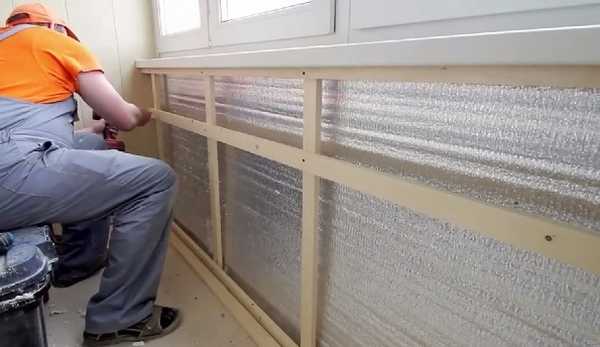

But how to glue penofol to concrete? After all, it is a very unstable material with high thermal conductivity, heat capacity and even the ability to accumulate moisture.
To fix the insulation on solid brick or concrete surfaces, the glue must have a number of properties:
- Have a high degree of adhesion and hygroscopicity;
- Do not destroy the material;
- Be resistant to weather conditions;
- Withstand large temperature drops;
- Have fungistatic and antiseptic properties;
- Do not lose their properties over time.
For the best fixation of any material, special solvents are added to the glue. They create a certain porosity of the bonded surfaces. Moreover, there are no universal solvents; each material needs its own.
But, for example, penofol is able to reliably adhere to penoplex without solvents.
If a bath or sauna is insulated, then when choosing an adhesive, one should pay attention to its heat resistance and resistance to water vapor.
Fig. 2 Fixing penofol on metal structures
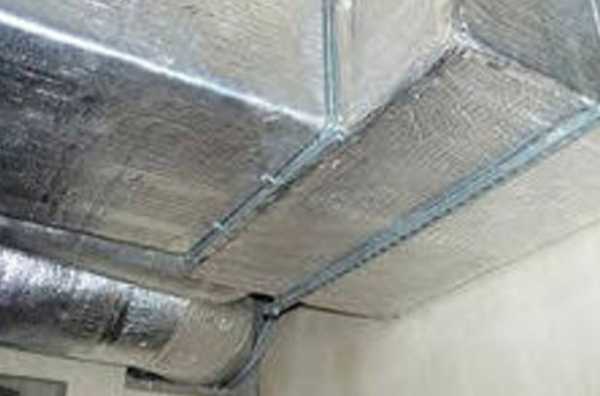

An important property is environmental safety, especially when using material for interior decoration. Only certificates of conformity can refute the toxicity of the glue. Import manufacturers often use toxicity certificates under the abbreviation EMICODE.
The technique of using the glue method of penofol is simple and cost effective. The insulation is very light, which means that it does not require the application of a large amount of adhesive. When fixing to metal, it is worth making sure that there is no water base in the composition, otherwise this will cause significant surface corrosion and damage to the insulation itself.
The surface for gluing foam foam should be flat, free of dust. Concrete walls or floors should be plastered without cracks, and metal surfaces should be treated with an anti-corrosion coating.
The glue is applied on the non-foil-protected surface of the penofol in an even layer. All sections of the insulation should be oiled. Particular attention is paid to the edges of the panel.
Before fixing penofol, hold for a time from several seconds to 1 minute, so that the glue dries a little. This will ensure the best adhesion. After the canvas is pressed to the surface, holding it, gently smooth it until it is completely fixed. Seams between pieces of insulation can be greased in advance or after finishing the entire surface.
Can be glued with glue from the "liquid nails" series, for example, "Moment-Montage",
just consider in which room you will glue penofol.
There are "liquid nails" of this brand for wet rooms (baths, saunas), there are for outdoor, for indoor work.
Also consider the material of the surface (metal, brick, concrete, etc.).
In general, the very idea of gluing penofol is not entirely correct.
If some air ducts are insulated with penofolm,
then penofol type "C" is bought, it is with an already applied adhesive layer (self-adhesive).
If the wall is insulated, then penofol is attached with an air gap (up to 2 cm, this is enough), that is, at the beginning of the crate, then penofol, fastening with brackets (you need a stapler), then counter-crate and finishing finishing material.
The joints are glued with foil tape,
overlap fastening is unacceptable, only end-to-end.
It is not necessary to glue penofol at all, it is attached differently, without an air gap it is not useful.
On the loggia you need penofol type "B", this is penofol with double-sided foil, one layer of foil (do not forget that penofol is reflective insulation) will not release heat from the room, the other will not allow the sun's rays to overheat the room in the summer (this is important for the loggia ).
Penofol type "B" is not glued, it is attached with a gap on the staples (see above).
In your case, the glue method will not work, just spoil the material and do not insulate the loggia, fix the penofol according to the technology described above (crate, gaps and so on).
Modern heaters like penofol require high-quality fastening. Penofol is polyethylene in a foamed state, it is covered with foil on top. Regardless of the type of finishing material: roll or sheet, a special adhesive is used as an attachment. It allows you to keep the technical properties of the material at a high level.
When choosing an adhesive composition for penofol, it is worth considering the type of surface to which it will be attached. The foil cover does not allow draft and heat to pass through. To save heat in the building, penofol is attached from the inside to the insulation. The air space should be 1 cm. Penofol must be fixed with an air gap.
As a heater, foam plastic is used with a width of 5-10 cm. The sheets must be glued tightly onto a special adhesive composition suitable for the foam. Plastic umbrellas provide additional fixation. A mesh is attached on top.
Selection Tips
As a rule, the tape is selected according to three criteria.
By material
- Foam rubber - has been used for insulation for a long time. Currently, it is included in the tape.

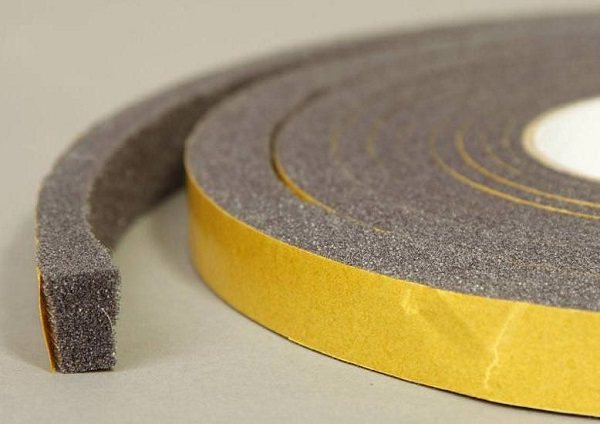
- low cost;
- high elasticity that allows you to close gaps of different sizes.
There are also disadvantages:
- due to the porous structure, moisture is quickly absorbed. The drying process takes a very long time;
- low durability. With prolonged use, the material turns yellow and crumbles.
- Polyvinyl chloride (PVC) - material with high strength and adhesion. He is not afraid of humidity and temperature fluctuations. The tapes are fixed on any surface and stretch well.

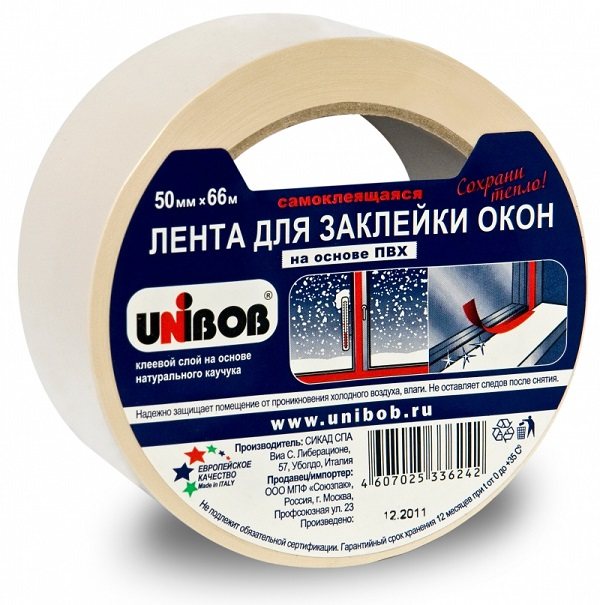
Unfortunately, such tapes are rarely used to insulate windows, as they increase the cost of the window structure by up to 15%.
- Rubber - used for the manufacture of two types of tapes: self-adhesive and sealing.
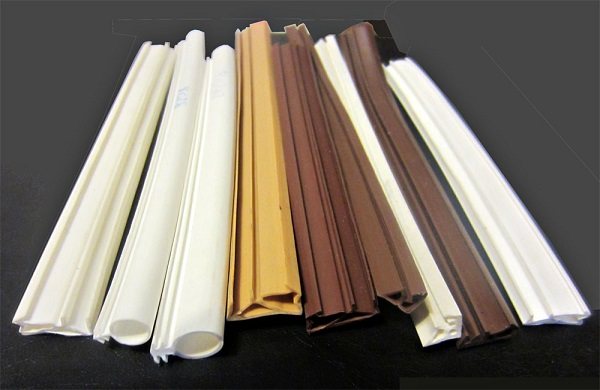

Tubular groove seals
Self-adhesive tapes are made on the basis of synthetic rubber and have all its positive qualities: elasticity and resistance to temperature fluctuations.
Rubber seals are not afraid of aggressive environments, therefore they serve for a very long time.
- Polyurethane foam (PPE) - a porous material made of foamed polyethylene.
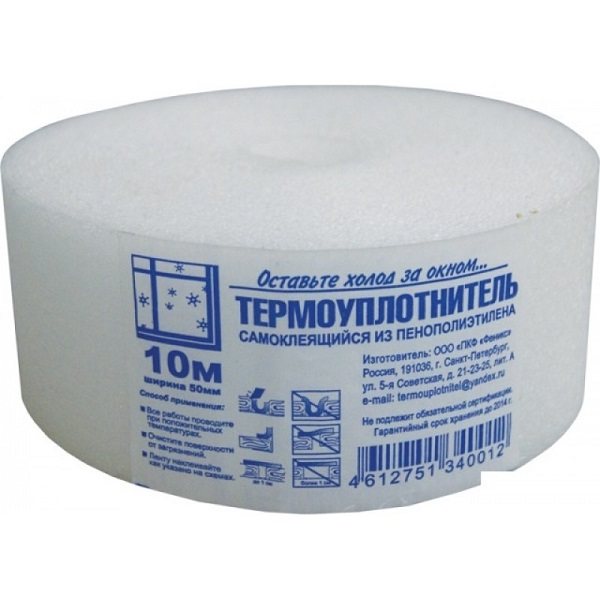

Due to their high elasticity, they are very effective tapes with small gaps. Good insulating qualities. Due to the presence of air in the structure, a heat-insulating environment is created.
Its use is limited by its ability to transform into a liquid toxic state at high temperatures.
By manufacturers
In hardware stores, there are tapes from different manufacturers.
However, only materials of the following brands are in demand:
- Russia - Profitrast, Econ, Bison.
- Germany - KIMTEC, Deventer.
- Poland - Sanok.
Domestic manufacturers, as a rule, work according to European technologies and produce high-quality material no worse than foreign samples. At the same time, although German and Polish tapes are more expensive, they last longer.
By cost
Insulation tapes are sold at retail and in coils from 6 to 10 meters.
Since a standard window requires about 5 meters of self-adhesive insulation, it is most often purchased at retail.
Advantages and disadvantages of penofol


Advantages of foil-clad material
Even a person who does not have the skills of a builder can easily cut this material and apply it to any surface. Since the main components of the product are polyethylene and food foil, rodents and all kinds of domestic pests are indifferent to penofol.
The material is environmentally friendly and will not ignite even if other household items are ignited. Due to the fact that the products practically do not allow steam to pass through, it is widely used to isolate public and home saunas.
With regard to the shortcomings, it is better to carry out insulation with penofol from the inside. The product is not recommended for use when decorating the outside of the living space. It is difficult to fix it with glue and adhesive solution, and it can tear when fixed with nails. Penofol is inconvenient from a technological point of view - this material is difficult to "mask" due to the softness of its structure.
We insulate wooden windows
What can not be said about old wooden frames, which have more than one layer of paint on the surface, deformed over time and do not close tightly.
In this case, before gluing the insulation for the window, it is necessary to prepare the surface.
- It is better to start by removing old paint and varnish surfaces. For this, you can use a special tool and a spatula.
Note! If the window was painted recently, then this item should be omitted.
- Then take a degreasing agent in your hands and carefully treat those areas where the rubber (foam) seal will be glued.
- Allow the liquid to dry, while trying to protect the surface from dust getting on it.
- At this time, cut the insulation into the windows with a small margin.
- When the surface is dry, stick on the first strip, after removing the protective film from the back. It is best to start with the vertical sides.
- Cut off the excess ends.
- Now glue the same strip on the opposite side of the window.
- Carefully measure the distance between the two bands and cut the seal.
- Stick it on.
The photo shows an example of how to glue insulation in a non-tearing way.
Advice! After you have completely finished the work, close the windows so that the insulation is well pressed to the surface and takes the required shape.
How to insulate the ceiling?


Penofol bonding
In order for work with this material to quickly argue and be crowned with a satisfactory result, you need to know some of the styling features. This will create reliable insulation that will last for many decades.
You must adhere to these rules:
- There should be an air space between the foam layer and the wall.
- For gluing to concrete, the surface must be prepared: level, eliminate cracks, prime.
- All joints of individual sheets of insulation should be carefully glued with construction tape or silicone sealant. Otherwise, depressurization of the structure may occur.
- Avoid the formation of joints at the corner joints of the ceiling and walls.
- Make sure that the foil side of foam foam does not come into contact with electrical wires and cables, since aluminum is an excellent conductor of electrical current. Therefore, all possible joints of material and wires must be insulated.
- The reflective side (the one covered with foil) should be directed towards the interior of the room.
- Fragments of material should not overlap each other. Condensation may collect at the edges, which is formed as a result of the ingress of moist air on the inner surface of the heat insulator.
- Before gluing penofol to the surface, it is necessary to ensure that all areas of the panel are smeared with an adhesive. During this time, the glue will dry out a little (the allowable time is 5 - 60 seconds), due to which maximum adhesion will be achieved.
- The glue-treated panel of insulation (its non-foil side) should be pressed to the surface, then gently flattened, holding until the sheet is completely fixed.


Laying penofol on the ceiling
Experts recommend penofol as an ideal heat insulator for the ceiling. This opinion is due to its low weight and small thickness, as well as the minimum amount of effort that will be required to apply to the person performing the installation.
For the successful completion of the work, the performer, in addition to penofol, will need wooden slats, hardware, tools and facing material.
- The ceiling is insulated in two passes. First, with the help of wooden slats, the initial layer is attached to the surface. For this, the thinnest type of penofol is usually chosen. When fixing the first layer, the slats are laid in the longitudinal direction, and when attaching the next layer, in the transverse direction.
- Insulation materials are covered with a lining of foam or other lightweight materials.
How to glue on gel polish, shellac
You can also glue the foil on your nails when using gel polish. This combination allows you to get a beautiful and durable manicure even at home. Let's take a closer look at this technique.
First, you need to complete the initial stages of gel polish manicure according to the traditional scheme. You need to polish and degrease your nails, apply a primer and base (be sure to seal the ends). Then the following options are possible:
- For a decal transfer, apply two coats of colored gel polish to the entire nail, leaving a sticky layer. Then transfer the coating using a sticky layer instead of glue, in the same way as with regular varnishes. After that, dry the second layer of color gel polish along with the foil and apply two coats of the top.
- To create a pattern with a cast effect (volumetric), after completing the initial steps, make a drawing with black varnish without a sticky layer and dry it completely. After that, translate the pattern in the usual way so that it covers all the bumps drawn. Secure the result with two layers of top with a sticky layer.


- Spectacular and fashionable design with the effect of broken glass will allow you to create a special foil for shellac or gel polish. To figure out how to work with it, the lesson in the video below will help you:
How to insulate a room on your own from the inside?


Insulation of the house inside
Before starting work, it is necessary to insulate the electrical wires and stock up on the necessary materials. In addition to penofol, the contractor will need assembly glue or a stapler, as well as wooden lathing and hardware.
- The first task facing the performer of this work is the construction of a wooden frame to which the penofol will be attached. The air layer separating the insulation from the wall should not be less than 20 millimeters.
- Then, armed with glue or a stapler, it is necessary to fix the insulation on a wooden frame, not forgetting that foil is an excellent conductor of electric current. All electrical wiring must be insulated in advance.
- Now is the time to install the second timber frame. Finishing materials will be applied to it. The maximum thickness of the structure is 20 millimeters.


